Day 2 of a three day long weekend of tours today. The weather was not as good as yesterday, cloudy with a bit of very light drizzle on and off first thing. But it dried out quickly and then even brightened up in the afternoon.
Our first destination for the day was Stiffkey Fen. There was no sign of the Cattle Egret in the field with the cows where we saw it yesterday, but then it does seem to be a late riser. As we parked the car, three Common Buzzards were hanging in the air over the small copse by the road.
The field by the permissive path has been recently cultivated and there were quite a few Black-headed Gulls and Lapwings in there this morning. As we walked along the path, we noticed some Stock Doves too. They were hard to see through the hedge so we continued on to the copse at the end and looked back. There were at least six of them and we had a good look at a couple of them in the scope, even though they had flown further over as we walked past. They were with a few Woodpigeons, allowing a good comparison.
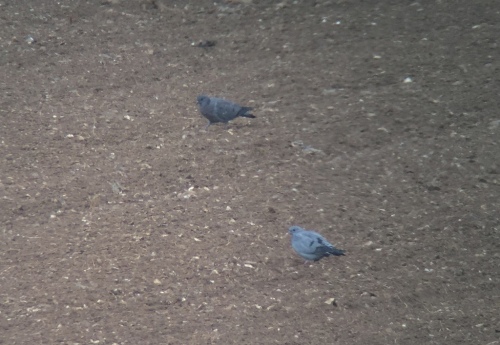 Stock Doves – there were at least 6 in this field this morning
Stock Doves – there were at least 6 in this field this morning
Down on the footpath along the river, we could hear a Chiffchaff calling. A male Blackcap flicked ahead of us through the trees on the bank, but was hard to see in all the leaves. A Cetti’s Warbler was trying to sing from the brambles the other side of the river, but hadn’t quite got it right yet. A Kingfisher called from deep in the thickest part of the trees beside the water.
As we got to the point where there is a gap in the trees and we could see over to the Fen, we noticed two large white shapes in the water amongst all the Greylag Geese. They were two Spoonbills. We found a point from where we could get one of them in the scope and it was a juvenile, with a dull, fleshy coloured bill. The second Spoonbill walked back to join it and we could see it was an adult, with a longer black bill with a distinct yellow tip.
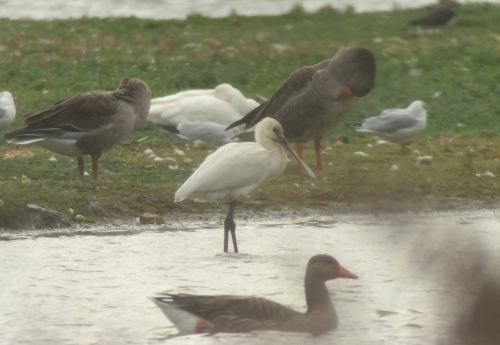 Spoonbill – 1 of 2 at the Fen today, this one a juvenile
Spoonbill – 1 of 2 at the Fen today, this one a juvenile
The two Spoonbills had a good preen and then started to walk out view behind the reeds, the adult having a quick look for food on the way, sweeping its bill from side to side through the water. There have been large numbers of Spoonbills here in recent weeks, adults and juveniles dispersing from the breeding colony at Holkham. Presumably as birds have started to head off south for the winter, the number has steadily declined so it was nice to see two still here today.
Having had a good look at the Spoonbills, we made our way on and up onto the seawall. The tide was still in and it was a big high tide today, so the channel and harbour the other side were full of water. Normally, this means that many of the waders from the harbour are roosting on the Fen, but there were actually fewer than normal on here today. They had obviously gone off to roost elsewhere.
There were plenty of ducks out on the Fen today – mostly Wigeon and Teal. A couple of Pintail were right down at the front of all the ducks, noticeably larger than the Teal just behind. The drakes of all these species are in their rather drab eclipse plumage at the moment, so they are not looking at their best. There were a few Gadwall too, and the drakes of these are already looking a lot smarter, as they moult earlier.
At this point, it had started to spit with drizzle, so we decided to walk a little further along the seawall. We looked back into the corner of the Fen and could see around 20 Greenshanks roosting in their usual spot. Unlike the godwits and Redshanks, they had come in as normal today. The Kingfisher called again and we turned to see it shooting across the seawall and disappearing out across the saltmarsh.
With the tide so high, we thought it might be difficult to see any waders roosting around the harbour this morning. Looking across in that direction, we spotted a pair of Brent Geese swimming past and behind them we noticed a group of waders roosting, including a Grey Plover still in breeding plumage. So we decided to head round there for a closer look. As we got to the bushes at the end of the seawall, we could hear a Goldcrest calling, presumably a migrant out here. It stayed tucked down out of the drizzle and we didn’t see it.
As we got round to the harbour, the group of waders took off and started to whirl round over the water in a tight flock. Thankfully, most of them landed again and through the scope we could see they were mostly Turnstones and a few Dunlin too. The smart Grey Plover had disappeared, but scanning along the southern edge we found several more Grey Plover roosting and, through the scope, we could see a couple of Bar-tailed Godwits asleep too. An Oystercatcher walked up into view. Out on the tip of Blakeney Point, we could see all the seals hauled out, Grey Seals and Common Seals.
Possibly the same two Brent Geese we had seen earlier then flew in and landed in the harbour channel in front of us. We had a great look at them, presumably a pair, with the larger male sporting a particularly bold white half collar. The Brent Geese are only now returning for the winter, as we saw yesterday, and there are still only small numbers back here so far.
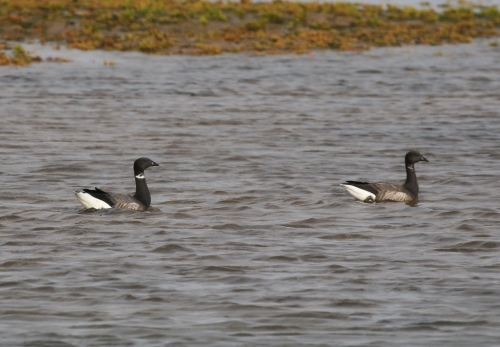 Brent Geese – this pair landed in the harbour channel in front of us
Brent Geese – this pair landed in the harbour channel in front of us
We had been scanning the boats periodically to see if the Kingfisher might be perched on one of them, as it sometimes likes to do, and on one scan we spotted it perched on the roof of an old boat out on the saltmarsh. Unfortunately, just as we tried to get it in the scope, it flew again. It hovered high over one of the saltmarsh channels for a couple of seconds before dropping back down out of view.
As we made our way back to the seawall, we could see one of the Spoonbills circling round. It dropped back down below the bank, but when we got up there we couldn’t see them where they had been on the Fen. A minute or so later, they flew up from behind the reeds, circled round in front of us, and disappeared off towards Morston, holding their necks and bills stretched out in front of them. A few more waders had appeared on the Fen – more Ruff, a handful of Redshank and a couple of Black-tailed Godwits, but it was still quieter than it should normally be.
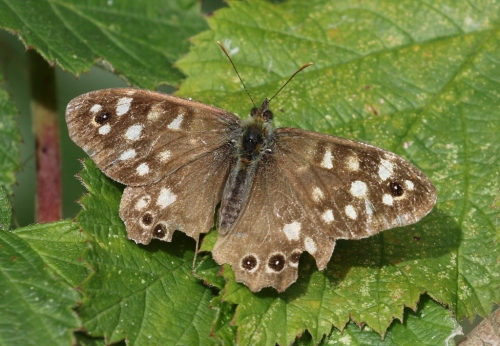 Speckled Wood – a rather tatty individual, basking in the sun
Speckled Wood – a rather tatty individual, basking in the sun
It had brightened up a bit as we walked back along the path towards the road. A tit flock flicked ahead of us through the sallows. A Great Spotted Woodpecker called. A small group of Greenfinches flew up from the brambles. There were a few butterflies and dragonflies out now – Red Admiral and Speckled Wood, Common Darter and Migrant Hawker – enjoying the sunshine.
After our experience yesterday, we thought it might be worth another look to see if the Cattle Egret had reappeared. We continued on down the permissive path which leads to the field where the cows are. As we turned the corner and saw all the cattle we immediately noticed a white bird in with them. The Cattle Egret had returned.
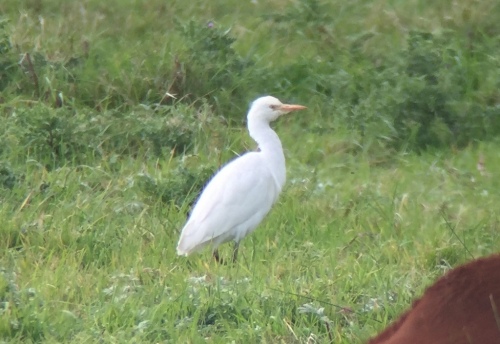 Cattle Egret – back with the cows later this morning
Cattle Egret – back with the cows later this morning
It was a much better view of the Cattle Egret from here, rather than viewing from the car on the road. We had a good look through the scope, noting its small yellow bill. It also had a wash of light orange on the crown, but otherwise looked quite white. The cows were all being rather lazy, sitting down, so the Cattle Egret wandered off through the grass and back to the ditch beyond. There were a couple of Grey Herons here too.
A couple of members of the group had asked about the Pallas’s Grasshopper Warbler, which had been at Burnham Overy since last Sunday, and were talking about possibly going down after we finished this evening to try to see it. It had not been reported today and has been a real skulker anyway, as is typical for the species – others have stood for 4-5 hours and not seen it. There has also been some trouble with twitchers cutting wire fences and trespassing in the fields to try to see it, so we have been steering clear of the site this week. But we had an hour to spare before lunch and it is a nice walk out beside the harbour, so we decided to head round that way. At least then, the group members concerned could see the lie of the land.
The tide had gone out now so we parked in the car park at Burnham Overy Staithe. We were just setting off when we looked up to see a Peregrine fly overhead and out across the channel. It was a young one, brown above and streaked below, and small so probably a male.We watched it fly off across the saltmarsh. As we got up onto the seawall, there were lots of Starlings and House Sparrows in the bushes. A Jay flew across the field beyond. A smart male Kestrel was perched in the top of the hedge and we got a great look at it before it finally took off.
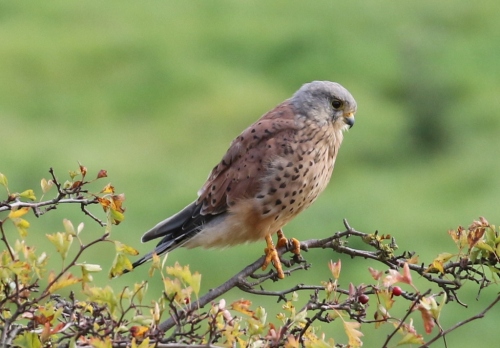 Kestrel – perched in the hedge at Burnham Overy Staithe
Kestrel – perched in the hedge at Burnham Overy Staithe
There were lots of waders out in the harbour as we walked out along the seawall. We stopped periodically to look through them. There were quite a few Ringed Plover out on the sandbank and a Grey Plover too. On the bank beyond, we could see more Ringed Plover with some Dunlin and a single Bar-tailed Godwit. A Spoonbill appeared nearby, before walking back into one of the saltmarsh channels. Further on, as we turned the corner, there were lots more Redshanks and a few Curlew.
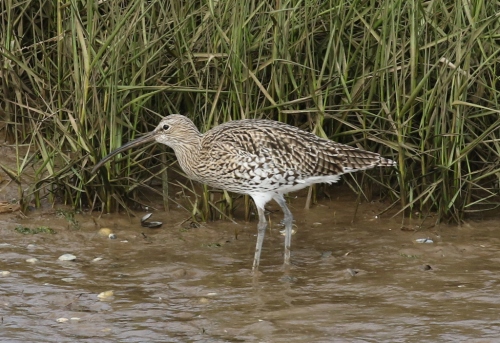 Curlew – feeding out in the harbour at Burnham Overy
Curlew – feeding out in the harbour at Burnham Overy
We could see a small crowd of people further along the seawall – waiting for the Pallas’s Grasshopper Warbler to appear. When we got round to them, we asked if there had been any sightings of the bird today and they confirmed there hadn’t. We had a quick chat about the bushes it had been favouring earlier, just in case the others should decide to come back again for a longer vigil later.
We did manage to add a few species to our tour list here. A couple of House Martins appeared overhead, flying back and forth. Most of the swallows and martins have left for the winter now, but there are still a small number lingering. A small flock of Pink-footed Geese circled over the grazing marshes. We decided not to hang around here, so set off back for lunch. We were almost back to the car park when we looked across towards Holkham and saw several thousand Pink-footed Geese in the distance, flying in from the fields and down to the grazing marshes.
After a nice break for lunch on the benches overlooking the harbour, we headed round to Holkham for the rest of the afternoon. After parking at the top of Lady Anne’s Drive, we set off to walk west on the inland side of the pines. We heard a Goldcrest calling from the holm oaks right at the start but expected to see quite a few of them along here today. However, it was unusually quiet in the trees.
A quick stop at Salts Hole produced four Little Grebes. We could hear lots of Pink-footed Geese calling from out on the grazing marsh and stopped to have a look at them from the gate before Washington Hide. There were at least a thousand in view, scattered across the grass, and many more besides just out of sight behind the reeds and hedges.
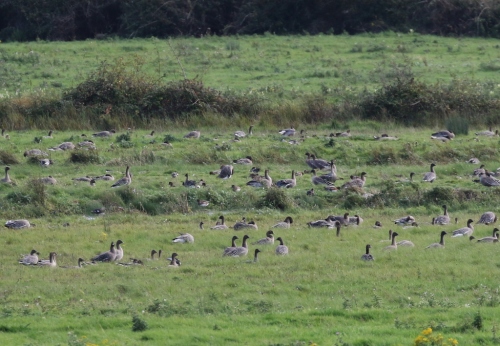 Pink-footed Goose – there were thousands already back at Holkham today
Pink-footed Goose – there were thousands already back at Holkham today
There were a few ducks on the pool in front of Washington Hide, Wigeon, Gadwall, Mallard and Shoveler, mostly hiding along the edge of the reeds. A juvenile Marsh Harrier flew in and dropped down into the reeds. A Red Kite circled over Holkham Park, off in the distance. There was no sign of any of the Great White Egrets at first though, until one walked out from behind the reeds and proceeded to walk slowly along the back of the pool, periodically stopping to peer into the reeds. It was clearly very big, tall, long-necked, and sporting a long yellow bill.
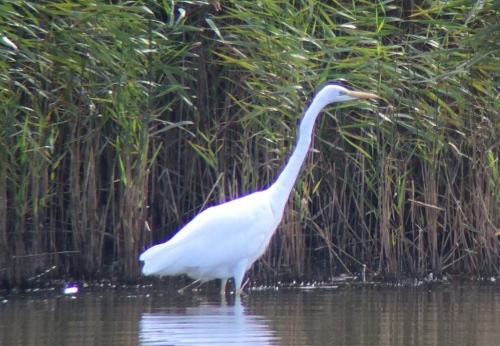 Great White Egret – walked across the back of the pool at Washington Hide
Great White Egret – walked across the back of the pool at Washington Hide
After having a good look at the Great White Egret, we carried on west along the path. We had been hoping to run into several tit flocks along here this afternoon, but they were all hiding in the trees. We came across one just before the crosstracks, but they were all deep in a very leafy holm oak. We could see the odd bird when it came out onto the edge, tits, Goldcrests and a couple of Chiffchaffs. But they never came out into the oaks and sycamores in front and quickly disappeared back into the pines behind. We then didn’t hear much more than a couple of Chiffchaffs between there and the west end of the pines, which is rather unusual.
We had not even seen a Hobby on our walk out, which has been a regular feature here in recent weeks. When we got to the end of the pines, we heard a tit flock calling and set off to try to see them. When the Long-tailed Tits started alarm calling, we looked across to see a Hobby scything through the open area of trees. It landed in the top of a pine briefly, where we could just see it through the branches, before turning and flying back out of the trees the way it had come.
Probably spooked by the Hobby, the tit flock moved quickly out of the sycamores and back into the pines. We tried to follow it for a couple of minutes, but it went up into the tops of the trees, where it was hard to see and moved rapidly deeper into the pines. We did see a Treecreeper working its way up the trunks. A quick look in the start of the dunes failed to produce anything, but we didn’t have time to go any further. We started to make our way back
Just the other side of the cross-tracks, a Hobby appeared right over our heads. It flew round above us, then suddenly powered across and scythed vertically down behind an oak tree. Wow! When it reappeared a few seconds later, it was eating something, lifting its feet up to its bill as it flew away, probably a dragonfly as there were lots out here in the sunshine. The Hobby circled round again over the edge of the trees and then landed in the top of a pine. We had to move a few metres back along the path to get the angle, but then we for it in the scope and had a great look at it. A stunning bird.
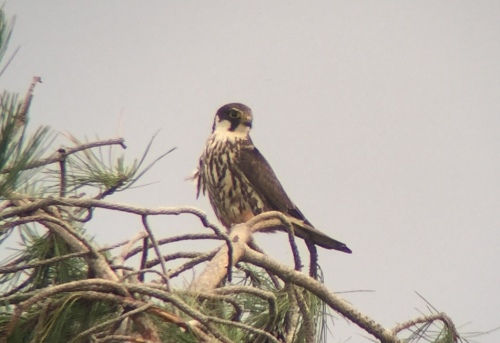 Hobby – catching insects around the edge of the pines
Hobby – catching insects around the edge of the pines
The Hobby stayed there for some time, looking round, but eventually dropped down from its perch and disappeared away through the trees. We continued our walk back. We were almost back to Lady Anne’s Drive when we found another tit flock. This time they were out of the pines and in the bushes and poplars on the south side of the path. We got much better views of Goldcrest and Treecreeper. There were Coal Tits and a couple of Chiffchaff with them too, but nothing more exotic today.
As the tit flock moved back into the pines, it was time for us to go too.
